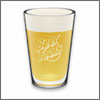Sorry, yeah, I meant to do that.
[size=+2]
Water Test APA #A Treated[/size]
[size=+1]10-A American Pale Ale[/size]
Author: Bobby
Date: 10/1/2009
 Size:
Size: .5 gal
Efficiency: 82.32%
Attenuation: 75.0%
Calories: 220.46 kcal per 12.0 fl oz
Original Gravity: 1.066 (1.045 - 1.060)
|==============================#=|
Terminal Gravity: 1.016 (1.010 - 1.015)
|============================#===|
Color: 5.62 (5.0 - 14.0)
|=========#======================|
Alcohol: 6.51% (4.5% - 6.2%)
|==========================#=====|
Bitterness: 47.2 (30.0 - 45.0)
|==========================#=====|
[size=+1]
Ingredients:[/size]
18 oz Maris Otter Pale Ale Malt
.125 oz Centennial (9.0%) -
added during boil, boiled 30 min
0.125 oz Centennial (9.0%) -
added during boil, boiled 10 min
0.25 oz Centennial (9.0%) -
added during boil, boiled 0.0 min
[size=+1]
Schedule:[/size]
Ambient Air: 70.0 °F
Source Water: 60.0 °F
Elevation: 0.0 m
00:03:00
mash in -
Liquor: 0.75 gal; Strike: 160.05 °F; Target: 154.0 °F
00:04:00
mashout -
Water: 0.25 gal; Temperature: 166.7 °F; Target: 157.0 °F
00:04:00
Strain -
Untitled Sparge: -0.13 gal sparge @ 168.0 °F, 0.0 min; Total Runoff: 0.75 gal
[size=+1]
Notes[/size]
Batch A mash was modified with .8g Gypsum and .3g MgSO4 Epsom Salt.
Calcium Magnesium Sodium Chloride Sulfate Alkalinity
(Ca ppm) (Mg ppm) (Na ppm) (Cl ppm) (SO4 ppm) (CaCO3 ppm)
94 20 28 53 213 60
50-150 10-30 0-150 0-250 50-350 See RA below
Residual Best for Chloride to Best for
Alkalinity this color Sulfate Ratio this style
-19 4 to 8 SRM 0.25 Very Bitter
Mash varied between 148 and 151 for an hour, then a 10 minute ramp up to 160F.
Sample A was 11brix preboil, B 10.5 brix.
[size=-1]Results generated by
BeerTools Pro 1.5.3[/size]
[size=+2]
Water Test APA #B Untreated[/size]
[size=+1]10-A American Pale Ale[/size]
Author: Bobby
Date: 10/1/2009
 Size:
Size: .5 gal
Efficiency: 71.09%
Attenuation: 75.0%
Calories: 189.88 kcal per 12.0 fl oz
Original Gravity: 1.057 (1.045 - 1.060)
|====================#===========|
Terminal Gravity: 1.014 (1.010 - 1.015)
|=====================#==========|
Color: 5.62 (5.0 - 14.0)
|=========#======================|
Alcohol: 5.61% (4.5% - 6.2%)
|==================#=============|
Bitterness: 47.2 (30.0 - 45.0)
|==========================#=====|
[size=+1]
Ingredients:[/size]
18 oz Maris Otter Pale Ale Malt
.125 oz Centennial (9.0%) -
added during boil, boiled 30 min
0.125 oz Centennial (9.0%) -
added during boil, boiled 10 min
0.25 oz Centennial (9.0%) -
added during boil, boiled 0.0 min
[size=+1]
Schedule:[/size]
Ambient Air: 70.0 °F
Source Water: 60.0 °F
Elevation: 0.0 m
00:03:00
mash in -
Liquor: 0.75 gal; Strike: 160.05 °F; Target: 154.0 °F
00:04:00
mashout -
Water: 0.25 gal; Temperature: 166.7 °F; Target: 157.0 °F
00:04:00
Strain -
Untitled Sparge: -0.13 gal sparge @ 168.0 °F, 0.0 min; Total Runoff: 0.75 gal
[size=+1]
Notes[/size]
Batch A mash was modified with .8g Gypsum and .3g NaCO4 Epsom Salt.
Calcium Magnesium Sodium Chloride Sulfate Alkalinity
(Ca ppm) (Mg ppm) (Na ppm) (Cl ppm) (SO4 ppm) (CaCO3 ppm)
94 20 28 53 213 60
50-150 10-30 0-150 0-250 50-350 See RA below
Residual Best for Chloride to Best for
Alkalinity this color Sulfate Ratio this style
-19 4 to 8 SRM 0.25 Very Bitter
Mash varied between 148 and 151 for an hour, then a 10 minute ramp up to 160F.
Additional .3g Gypsum and .1g Epsom Salt added to Batch A boil.
[size=-1]Results generated by
BeerTools Pro 1.5.3[/size]








